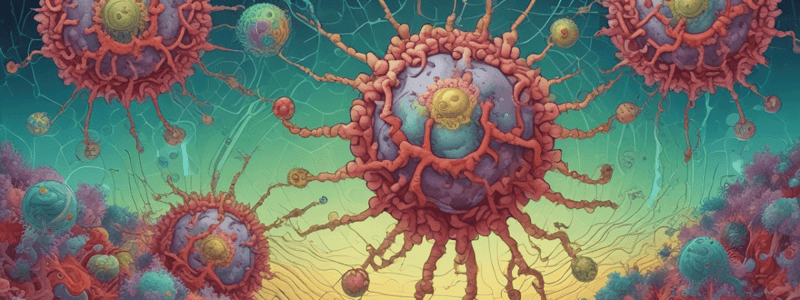Podcast
Questions and Answers
What is the characteristic of Eubacteria cell walls?
What is the characteristic of Eubacteria cell walls?
- Lack a cell wall
- Composed of a lipid and protein complex
- Composed of a carbohydrate and protein complex (correct)
- Primarily made up of cellulose
How do Eubacteria typically reproduce?
How do Eubacteria typically reproduce?
- Through binary fission (correct)
- Through mitosis
- Through photosynthesis
- Through meiosis
What is a characteristic of Eubacteria in terms of cellular structure?
What is a characteristic of Eubacteria in terms of cellular structure?
- They have a large nucleus
- They lack a nucleus (correct)
- They have a cell wall made of cellulose
- They have multiple cells
How should a species, genus, and family of a virus be formatted when used in a taxonomic sense?
How should a species, genus, and family of a virus be formatted when used in a taxonomic sense?
What is the rule for capitalizing a virus name?
What is the rule for capitalizing a virus name?
What is the rule for abbreviating a virus name?
What is the rule for abbreviating a virus name?
What is a characteristic unique to fungi among the microorganisms mentioned?
What is a characteristic unique to fungi among the microorganisms mentioned?
What is the primary mode of nutrition in fungi?
What is the primary mode of nutrition in fungi?
Which of the following is a characteristic of helminths?
Which of the following is a characteristic of helminths?
What is the primary function of light, water, and carbon dioxide for algae?
What is the primary function of light, water, and carbon dioxide for algae?
What is a characteristic shared by both algae and fungi?
What is a characteristic shared by both algae and fungi?
Which of the following is a characteristic of molds?
Which of the following is a characteristic of molds?
What is the primary reason viruses are not considered living organisms?
What is the primary reason viruses are not considered living organisms?
What is the main purpose of Koch's Postulates?
What is the main purpose of Koch's Postulates?
What is the term for an individual who is infected with a pathogen but does not show symptoms of the disease?
What is the term for an individual who is infected with a pathogen but does not show symptoms of the disease?
What is the characteristic of opportunistic pathogens that distinguishes them from other pathogens?
What is the characteristic of opportunistic pathogens that distinguishes them from other pathogens?
What is the structure of a virus particle or virion?
What is the structure of a virus particle or virion?
What is the fourth criterion of Koch's Postulates?
What is the fourth criterion of Koch's Postulates?
What is the primary goal of treatment in medical microbiology?
What is the primary goal of treatment in medical microbiology?
What is the term for the study of the causes or origins of diseases or conditions?
What is the term for the study of the causes or origins of diseases or conditions?
What is the term for the process by which a disease or condition develops and progresses within the body?
What is the term for the process by which a disease or condition develops and progresses within the body?
What is the term for the measures and practices implemented to prevent and reduce the transmission of infectious agents?
What is the term for the measures and practices implemented to prevent and reduce the transmission of infectious agents?
What is the term for the science of bacteria that can cause infectious diseases in humans?
What is the term for the science of bacteria that can cause infectious diseases in humans?
What is the term for the microorganisms that reside on either surface of the body or at mucosa without harming human health?
What is the term for the microorganisms that reside on either surface of the body or at mucosa without harming human health?
What is a major limitation of the germ theory of disease?
What is a major limitation of the germ theory of disease?
Which of the following is a reason why not all pathogens are culturable?
Which of the following is a reason why not all pathogens are culturable?
What is implied by the statement 'infectious disease is primarily caused by transmission of an organism from one host to another—is a gross oversimplification'?
What is implied by the statement 'infectious disease is primarily caused by transmission of an organism from one host to another—is a gross oversimplification'?
Why do pathogens may become less pathogenic when grown in vitro?
Why do pathogens may become less pathogenic when grown in vitro?
What is an example of a multifactorial disease?
What is an example of a multifactorial disease?
What is the main argument against the germ theory of disease?
What is the main argument against the germ theory of disease?
Flashcards are hidden until you start studying




